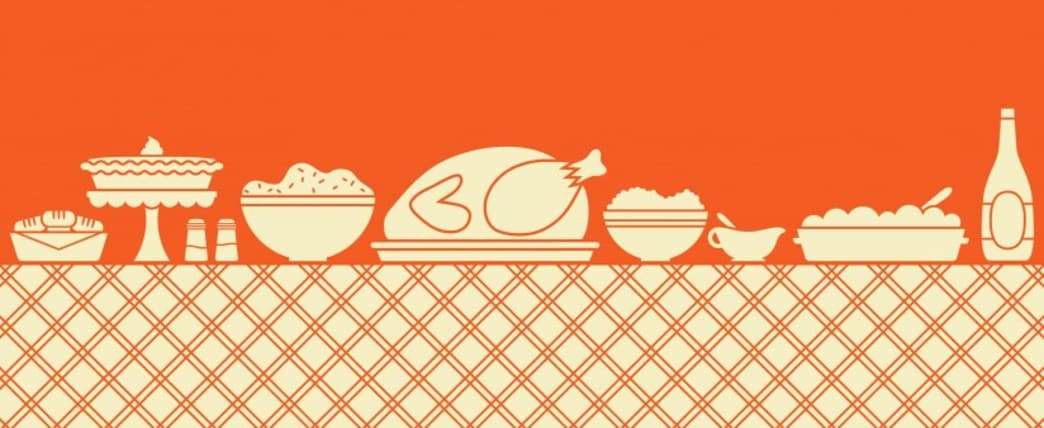
Q: Just a few months ago, I learned that avoiding gluten dramatically improves my depression and achy joints. I know the basics of staying away from obvious sources, such as croutons, bread, stuffing, and regular baked goods. However, this will be my first holiday season avoiding gluten, and I’m wondering if you could clue me in on hidden or not-so-obvious gluten sources to watch out for during the holidays. —Vicky M., Pittsburgh
A: You’d be surprised: Gluten, a protein found in many grains such as wheat, spelt, kamut, rye, barley, and most commercial oat products, lurks in all kinds of unsuspected places.
How to have a gluten-free holiday
1. Soup
Gluten is found in a variety of ingredients in many commercial soups, from thick “cream ofs” to clear broths and bouillon cubes, so it’s safest to avoid soup altogether if you’re a guest for a holiday meal or eating in a restaurant. At home, make soup out of homemade broth, or use broth or soup that’s certified gluten-free.
2. Gravy
Gravy is another common source of gluten: A roux made with wheat-based flour and fat is typically used to prepare it. For gluten-free gravy, start with coconut flour, then add stock and mix with an immersion blender. Or simply make a slurry by whisking 1 Tbs. of arrowroot powder into 1/4 cup water and stir until completely dissolved. Add the slurry to a hot mixture of turkey drippings and gluten-free stock or broth, and whisk until thickened and smooth.
3. Mashed Potatoes
Here’s one that surprised even me! If they’re homemade, most mashed potatoes are gluten-free. But some people (and certain restaurants) add a little flour to thicken their mashed potatoes. Ask to be sure.
4. Cream-based Dishes
Be wary of any dish with a cream base, because a gluten-containing cream soup was likely used to prepare it. For example, traditional green bean casserole is made with gluten-containing cream of mushroom soup. For a healthier, gluten-free choice, make green beans with toasted slivered almonds instead.
5. Turkey
Unprocessed, plain turkey is gluten-free. But read labels carefully, and make sure the turkey hasn’t been seasoned or marinated with something that contains gluten, or injected with brine that contains gluten. If you aren’t sure, ask. Also make sure that the turkey isn’t packed with gluten-containing bread stuffing. If you plan to eat out at a restaurant, always call and ask the chef or manager.
6. Imitation turkey and meat products
Many plant-based faux turkey products, including Tofurky Veggie Roast, and other meat substitutes, are made from vital wheat gluten, a concentrated source of the problematic protein. Skip the meat alternative, and use naturally gluten-free or certified gluten-free ingredients to prepare an assortment of meatless seasonal dishes instead.
7. Scrambled eggs and omelets
Traveling during the holidays and eating out in restaurants? Beware that some add pancake batter when making scrambled eggs and omelets, or use packaged egg products that already contain batter or flour to make the eggs fluffier. They also tend to cook these egg dishes, as well as plain old fried eggs, on the same grill where pancakes were made. Ask questions before ordering eggs. Based on your sensitivity to gluten, you may want to choose the safer route by ordering poached or hard-boiled eggs.
8. Some teas
Watch out for special holiday tea blends, some of which contain gluten-based flavors or barley malt as a sweetener. Know that single-ingredient teas, such as black tea, green tea, white tea, and rooibos tea, are naturally gluten-free. But some flavored teas whose base ingredients are naturally gluten-free contain added gluten ingredients. Read the ingredients before you buy, or seek out certified gluten-free varieties or teas labeled gluten-free.
9. Alcohol
Commercial beer, unless labeled otherwise, contains gluten. Rye, whiskey, bourbon, and scotch also are made from gluten grains. The distillation process used to make these beverages generally makes them safe to consume, but some people with celiac disease (an autoimmune reaction to gluten) report adverse reactions when drinking these liquors. If you’d prefer to drink alcohol made completely without ingredients containing gluten, opt for rum, potato vodka, or tequila.
While wine is inherently gluten-free as it is made from grapes, some wines that contain added colorings or flavorings might not be gluten-free. You’ll need to contact the manufacturer to be sure. Also be aware that some wine coolers contain additional ingredients that aren’t gluten-free.
10. Stamps and envelopes
Do you like to mail out Christmas or holiday greeting cards to friends and family? Be careful! The adhesive that makes stamps and envelopes stick can contain gluten. To avoid taking a chance, use a sponge to dampen envelopes, or try the self-adhering kind.
Did You Know?
The adhesive on many stamps and envelopes contains gluten. So be careful when mailing those holiday cards.
Gluten Basics
People can react to gluten by developing celiac disease or non celiac gluten sensitivity. Celiac disease is an autoimmune disease in which the immune system attacks both gluten and the small intestine, leading to the damage in the small intestine that characterizes the condition. Non celiac gluten sensitivity is a non autoimmune reaction to gluten that can cause symptoms similar to or identical to those experienced by people with celiac disease; however, it does not lead to the gut damage associated with celiac disease.
Symptoms of celiac disease or gluten sensitivity run the gamut from gastrointestinal issues to anemia, bone disease, depression, fatigue, and migraines.
“Gluten-Free” Foods
The most surprising thing for many people is that virtually all foods labeled “gluten-free” aren’t completely “free” of gluten: Most adhere to the FDA’s labeling guidelines, which means they contain less than 20 ppm gluten, but those are still levels that may cause reactions in some people.
To err on the side of caution, limit gluten-free labeled packaged foods, and pick and choose the ones you buy carefully. Look for foods that are certified by celiac organizations such as the National Celiac Association, the Gluten Intolerance Group (which runs the Gluten-Free Certification Organization or GFCO program), and the Allergen Control Group/Canadian Celiac Association.
Avoiding Gluten
Especially during the holidays, but also year-round, emphasize fresh vegetables, fruits, and unprocessed poultry, fish, and meat. Using as many of these naturally gluten-free ingredients as possible—by making a vegetable stuffing instead of a bread stuffing, for instance—is the most surefire way to both avoid gluten and eat a nutrient-rich diet that supports overall health.
Written by Melissa Diane Smith for Better Nutrition and legally licensed through the Matcha publisher network. Please direct all licensing questions to legal@getmatcha.com.

